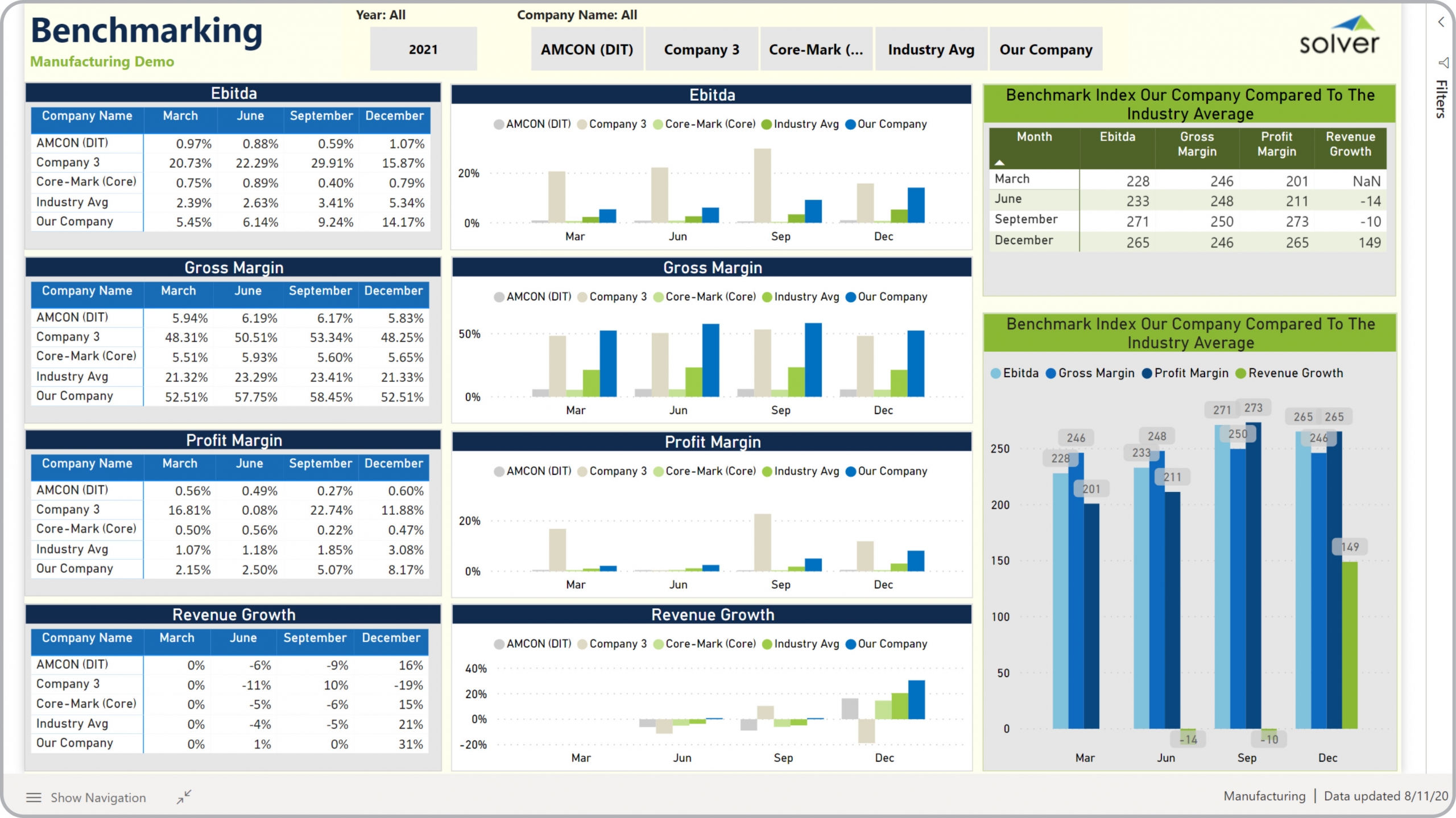Benchmarking Dashboard for Manufacturing Companies
What is a
Benchmarking Dashboard
? Benchmarking dashboards are considered competitive comparison tools and are used by CFOs and Executives to analyze internal KPIs against those of the manufacturing industry. Some of the main functionality in this type of dashboard is that it enables the user to select which companies (including the industry average) and year to use in the analysis, and then it will provide graphical comparison. The dashboard includes quarterly data for: 1) EBITDA, 2) Gross Margin, 3) Profit Margin, and 4) Revenue Growth. You find an example of this type of dashboard below.
Purpose of
Benchmarking Dashboards Manufacturing companies use Benchmarking Dashboards to make executives aware of- and accountable for the company's performance in comparison to other businesses and the industry average. When used as part of good business practices in Financial Planning & Analysis (FP&A) departments, an organization can improve and speed up its strategies, and it can reduce the chances that the company falls behind competition because it is only measuring itself against internal targets.
Example of a
Benchmarking Dashboard Here is an example of a Dashboard that benchmarks your own KPIs against selected companies and the industry average. [caption id="" align="alignnone" width="2560"]
 Example of a Benchmarking Dashboard for Manufacturing Companies[/caption] You can find hundreds of additional examples
here
Who Uses This Type of
Dashboard
? The typical users of this type of dashboard are: Board members, executives, CFOs, analysts.
Other Reports Often Used in Conjunction with
Benchmarking Dashboards Progressive Financial Planning & Analysis (FP&A) departments sometimes use several different Benchmarking Dashboards, along with profit & loss reports, balance sheets, cash flow statements, KPI dashboards and other management and control tools.
Where Does the Data for Analysis Originate From? The Actual (historical transactions) data typically comes from enterprise resource planning (ERP) systems like: Microsoft Dynamics 365 (D365) Finance, Microsoft Dynamics 365 Business Central (D365 BC), Microsoft Dynamics AX, Microsoft Dynamics NAV, Microsoft Dynamics GP, Microsoft Dynamics SL, Sage Intacct, Sage 100, Sage 300, Sage 500, Sage X3, SAP Business One, SAP ByDesign, Acumatica, Netsuite and others. In analyses where budgets or forecasts are used, the planning data most often originates from in-house Excel spreadsheet models or from professional corporate performance management (CPM/EPM) solutions.
What Tools are Typically used for Reporting, Planning and Dashboards? Examples of business software used with the data and ERPs mentioned above are:
Example of a Benchmarking Dashboard for Manufacturing Companies[/caption] You can find hundreds of additional examples
here
Who Uses This Type of
Dashboard
? The typical users of this type of dashboard are: Board members, executives, CFOs, analysts.
Other Reports Often Used in Conjunction with
Benchmarking Dashboards Progressive Financial Planning & Analysis (FP&A) departments sometimes use several different Benchmarking Dashboards, along with profit & loss reports, balance sheets, cash flow statements, KPI dashboards and other management and control tools.
Where Does the Data for Analysis Originate From? The Actual (historical transactions) data typically comes from enterprise resource planning (ERP) systems like: Microsoft Dynamics 365 (D365) Finance, Microsoft Dynamics 365 Business Central (D365 BC), Microsoft Dynamics AX, Microsoft Dynamics NAV, Microsoft Dynamics GP, Microsoft Dynamics SL, Sage Intacct, Sage 100, Sage 300, Sage 500, Sage X3, SAP Business One, SAP ByDesign, Acumatica, Netsuite and others. In analyses where budgets or forecasts are used, the planning data most often originates from in-house Excel spreadsheet models or from professional corporate performance management (CPM/EPM) solutions.
What Tools are Typically used for Reporting, Planning and Dashboards? Examples of business software used with the data and ERPs mentioned above are:
- Native ERP report writers and query tools
- Spreadsheets (for example Microsoft Excel)
- Corporate Performance Management (CPM) tools (for example Solver)
- Dashboards (for example Microsoft Power BI and Tableau)
Corporate Performance Management (CPM) Cloud Solutions and More Examples
Learn More About Solver CPM For Manufacturing
March 30, 2021
TAGS:
Reporting,
Solver,
plant,
report writer,
Microsoft,
benchmark,
manufacturing,
template,
practice,
Acumatica,
visualization,
Netsuite,
Finance,
planning,
GP,
dashboard,
Business Central,
excel,
ax,
forecast,
Budget,
Dynamics 365,
analysis,
budgeting,
KPI,
Cloud,
Software,
Tableau,
SAP,
example,
best,
Sage,
BC,
D365,
NAV,
Intacct,
facility,
CPM,
report,
SL,
Management,
dynamics,
Power BI,
benchmarking dashboard,
industry,
quarterly benchmark

